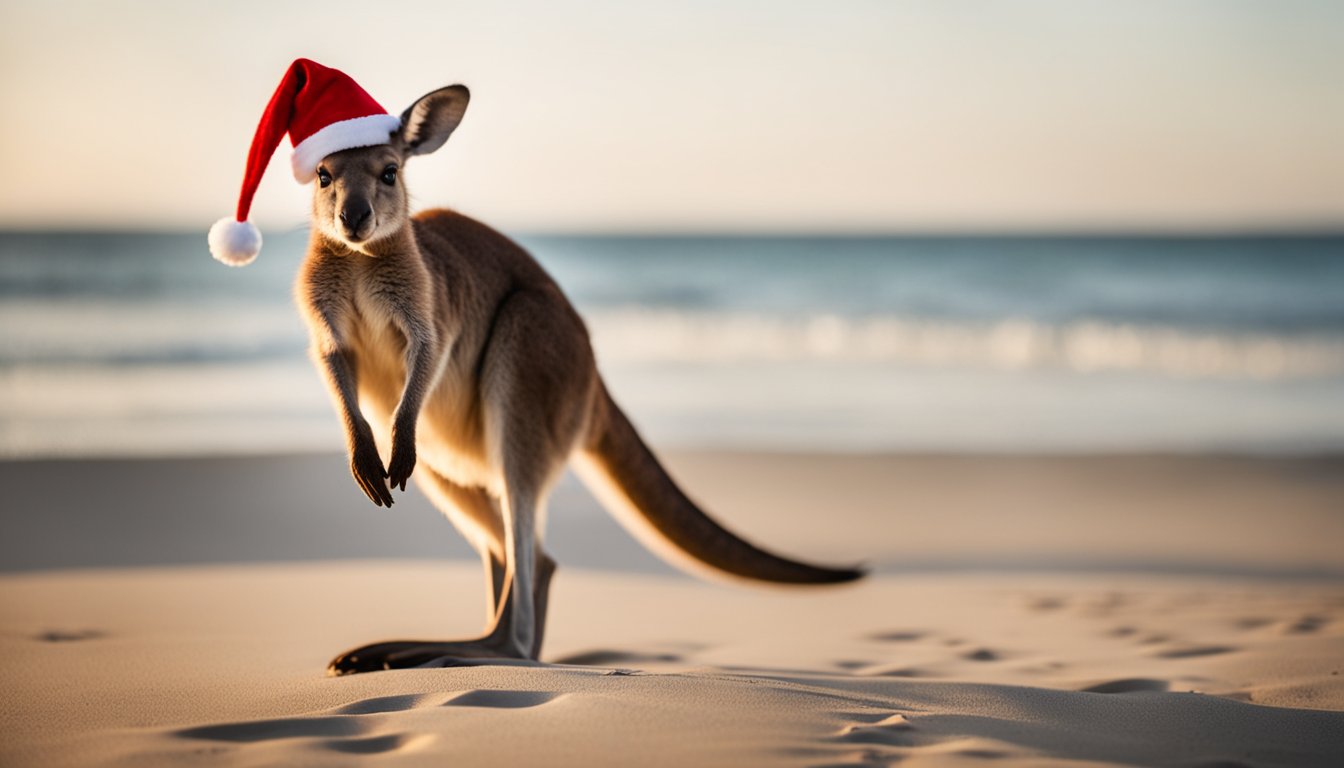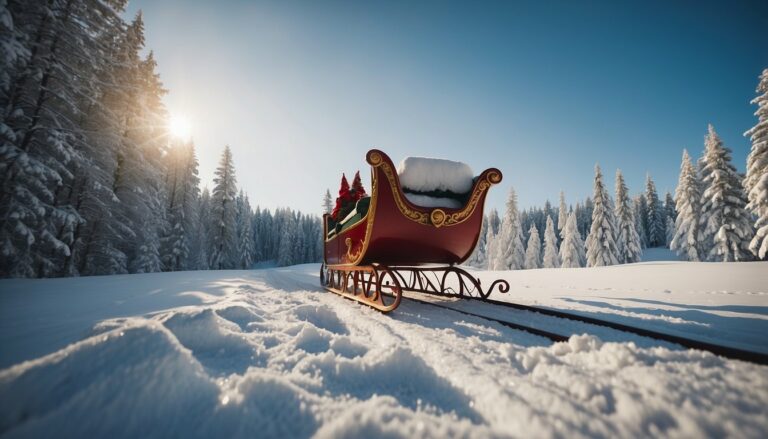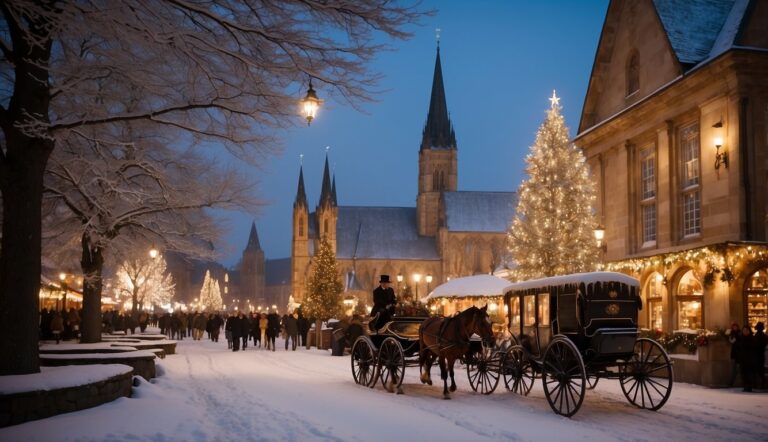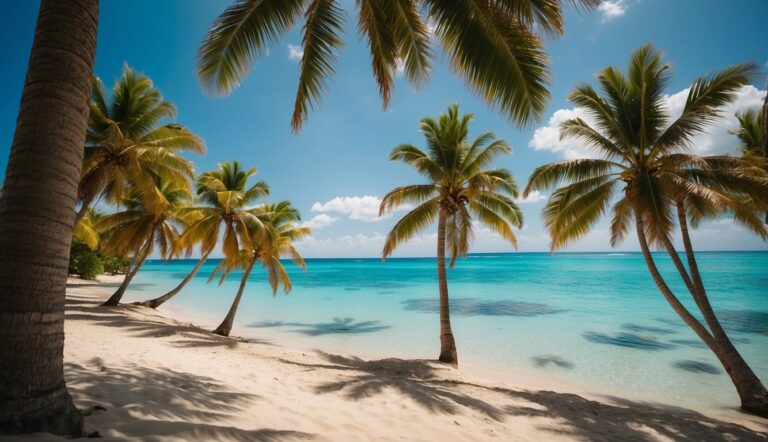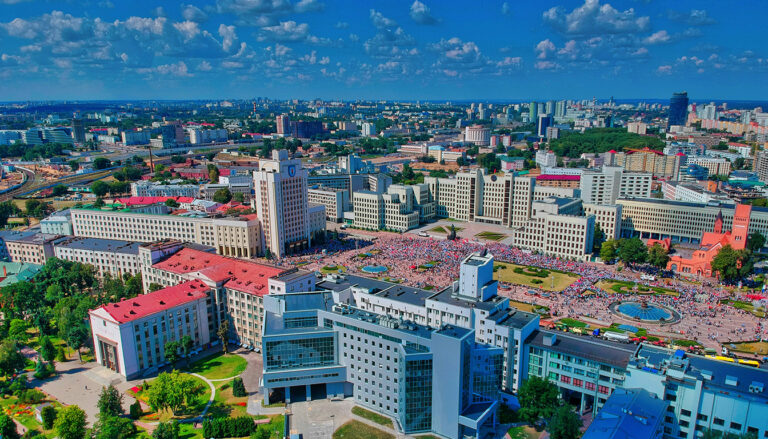Christmas in Australia: Traditions Down Under in the Summer Sun
Christmas time in Australia is characterized by unique traditional festive customs and the country’s distinct summertime climate.
Falling during the Southern Hemisphere’s warmest months, Australian celebrations have adapted typical activities such as decorating Christmas trees and exchanging gifts to align with the sunny environment.
These adaptations are evident in the nation’s embrace of outdoor activities, beach gatherings, and barbecues to celebrate the season.

While Australians inherit many holiday traditions from European origins, the festivities take on a local flavour.
The presence of a surfing Santa Claus, the enjoyment of seasonal seafood, and the popularity of ‘Christmas in July’ events illustrate a blend of cultures and the Aussies’ innovative approach to holiday observance.
Christmas carol events, which have become a staple in Australian Christmas celebrations, bring communities together in large outdoor venues or beaches, signifying the nation’s collective spirit during Christmas.
Despite the climatic differences, the essence of Christmas in Australia echoes universal themes of joy, generosity, and community.
From the urban spectacle of the Myer Christmas windows in Melbourne to the coastal tradition of festive sand sculptures, Australia offers a distinctive and vibrant holiday experience that stands out amongst global Christmas celebrations.
Christmas Season in Australia

In Australia, Christmas is a unique blend of traditional festivities adapted to the warm summer climate that characterizes December.
The country adds its unique spin to the season’s spirit with its customs, creating a Christmas experience like no other.
The Festive Atmosphere
As the Christmas season approaches, Australians eagerly anticipate celebrating during the warm summer months.
Streets and homes are adorned with Christmas decorations, including the iconic Christmas bush, a native Australian plant with red flowered leaves that captures the essence of the season.
Christmas cards exchange hands, spreading goodwill and cheer, a practice that has endured since the 19th century.
Pre-Christmas Events
November marks the beginning of pre-Christmas events, with communities gathering at Carols by Candlelight services to sing traditional songs.
These events often occur outdoors, capitalizing on the pleasant summer evenings.
Many churches and communities also organize festive markets and pageants, engaging locals and tourists in a celebratory mood.
Public Holidays and Significance
Christmas Day, December 25, is a public holiday across Australia, allowing families and friends to gather and partake in the holiday meals and gift exchanges that typify the season.
The public holidays extend into Boxing Day, providing opportunities for people to continue their celebrations or take advantage of post-Christmas sales.
For many, this period also signals the beginning of the summer holidays, a time to relax and enjoy the abundant outdoor activities across the country.
Australian Christmas Traditions

Australian Christmas traditions meld the country’s British heritage with its warm summer season, creating a distinctive way of celebrating the festive season.
Decorations and Themes
Australian homes and public spaces often display Christmas decorations imbued with traditional winter and local summer themes.
Christmas trees are commonly erected and adorned with lights and ornaments.
Public places, like Sydney’s Martin Place, are illuminated with elaborate Christmas light displays.
Figures of Santa Claus, despite his traditional winter garb, are widespread, often depicted enjoying summer activities like surfing to reflect the season.
Food and Feasts
The Christmas feast in Australia is a blend of traditional and local cuisine.
While some families opt for a more customary Christmas lunch or dinner with turkey or chicken, others may fire up the barbecue for a casual outdoor meal.
Seafood is a favoured choice, reflecting the country’s oceanic bounty.
The pavlova, a meringue-based dessert topped with fresh fruit, is an iconic sweet treat enjoyed during Christmas. But you can also find the customary trifle on many a Christmas dessert list. A dessert comprises sponge cake, fruit, jelly, and custard layers.
Sports and Recreation
Outdoor activities play a significant role in Australian Christmas celebrations.
Cricket matches are common pastimes, either impromptu games in backyards or the iconic Boxing Day Test match.
The Sydney to Hobart Yacht Race, which starts on Boxing Day, is a key event in the sporting calendar as well.
Families and friends gather on beaches and parks, embracing the festive spirit while enjoying the sun, often with a cold beer or a glass of wine in hand.
Cultural Observances

In Australia, Christmas is marked by a mesh of traditional religious observances and vibrant community gatherings that showcase a blend of local culture and inherited customs.
Religious Services
Churches across Australia hold services on Christmas Eve and Christmas Day, where Christians come together to celebrate the birth of Jesus Christ.
These church services often feature readings from the Bible, traditional hymns, and the singing of carols. Candles are commonly used to symbolize the light of Christ entering the world.
Community and Social Gatherings
Community gatherings are integral to Australian Christmas celebrations.
Events such as Carols by Candlelight are a hallmark, attracting thousands.
During these gatherings, people come together, typically holding candles and singing carols.
Such events highlight the communal spirit and often serve charitable causes.
Iconic Australian Christmas

Australian Christmas is distinct with its unique celebration during the summer season and alternative traditions that suit the warmer climate.
Unique Australian Elements
In Australia, Santa Claus adapts to the local context.
Instead of his traditional heavy red suit, he may wear lighter attire to cope with the Australian summer heat.
The image of Santa riding a sleigh pulled by kangaroos instead of reindeer captures the imagination, creating a blend of universal Christmas imagery with an Australian twist.
Often, Santa is depicted on a surfboard, embracing Australia’s beach culture.
Aussies also enjoy a cold beer with their festivities, complementing the seasonal warmth.
Christmas at the Beach
Christmas for many Australians involves heading to the coast to enjoy a day at the beach.
Bondi Beach, in particular, is a famous spot where thousands gather to celebrate with swimsuits, thongs (flip-flops), and sun hats.
Barbecues sizzle as families and friends enjoy picnics on the sand, and the ocean becomes a refreshing alternative to a snow-covered landscape.
Christmas at the beach embodies the spirit of an Australian Christmas, where the festive mood is celebrated under the sun with surfboards and sandcastles.
Geographical Celebrations in Australia

Australian cities each have unique Christmas traditions that illuminate the festive season with local flavours and grand events.
From iconic beach celebrations to spectacular citywide events, Australia’s geographical diversity offers various Christmas experiences.
Sydney
Sydney’s Christmas is iconic for its festive event, Carols in the Domain, a large open-air concert that attracts thousands of participants for communal singing and celebration.
The city is also known for its stunning decorations and lights, with the Sydney Christmas Parade bringing festivity to the streets with floats and performances.
The holiday spirit extends to the famous Bondi Beach, where locals and tourists often spend Christmas Day enjoying a sun-soaked holiday in contrast to the traditional winter setting elsewhere.
Melbourne
Melbourne celebrates Christmas with a cultural twist at the Sidney Myer Music Bowl, where the annual Carols by Candlelight is hosted.
This event features performances by popular artists and community singing under the summer sky.
The city’s central streets and laneways are adorned with shimmering lights and Christmas displays, embracing the holiday spirit with a unique Australian warmth.
Other Major Cities
In Hobart, the Christmas season is highlighted by a vibrant festive parade, incorporating a mix of colour and energy that draws crowds from across Tasmania.
Adelaide boasts the longstanding tradition of the Adelaide Christmas Pageant, known to be the largest of its kind in the world, drawing huge audiences with its fairy-tale-like display.
In Western Australia, Perth lights up with its own Christmas decorations and activities, including a variety of community events and night markets.
The capital city, Canberra, holds its own with beautiful light displays and Christmas celebrations, while in Queensland, cities like Brisbane embrace the holiday with their warm weather festivities and events by the beach.
Gift-Giving and Shopping

In Australia, Christmas shopping and the exchange of gifts are steeped in tradition, with consumers seeking both meaningful and enjoyable presents for their loved ones.
Purchasing Gifts
Australians often start their Christmas shopping well in advance to avoid the rush and to take advantage of pre-Christmas sales.
Stores nationwide gear up for the season, with many offering extended hours and special promotions to facilitate the search for the perfect gift.
The range of gifts includes everything from handcrafted items that add a personal touch to innovative gadgets and luxury items.
Online shopping has also become increasingly popular, providing a convenient option for those who prefer to avoid crowded malls.
Key Shopping Periods:
- November to December: Pre-Christmas sales
- Boxing Day: Post-Christmas sales start
- January: Continued sales and discounts
Exchanging Presents
The act of giving is a core aspect of Christmas celebrations in Australia.
Families and friends exchange presents on Christmas Day, usually gathering under the Christmas tree.
The tradition embodies the spirit of generosity and thoughtfulness.
In the workplace, secret Santa exchanges are common.
Boxing Day is marked by the continuation of gift-giving, particularly in charitable acts and sharing with those less fortunate.
Post-Christmas Celebrations

In Australia, the festive mood extends beyond Christmas Day, as several events and traditions mark the calendar during the post-Christmas period, keeping the celebratory spirit high.
Boxing Day Events
Boxing Day, celebrated on December 26th, is synonymous with sports and shopping.
Australians gather with families and friends to watch the anticipated Boxing Day Test Match, a cricket event held at the Melbourne Cricket Ground.
This cricket match is one of the most popular sporting events in the country.
In addition to cricket, the Sydney to Hobart Yacht Race is a highlight, beginning in Sydney and ending in Hobart.
This prestigious yacht race is a test of skill and endurance, attracting viewers both along the coast and on television.
Comparison with Other Countries
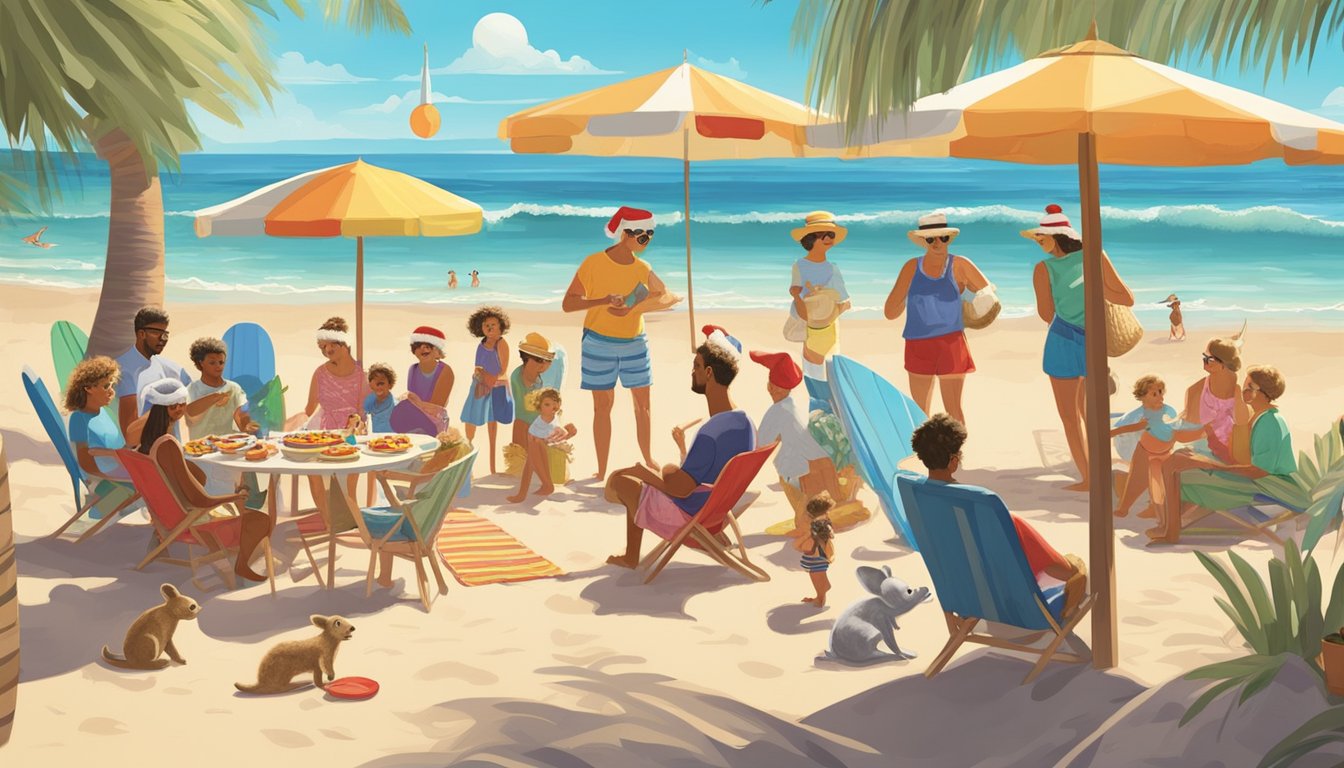
The festive season in Australia contrasts noticeably with worldwide traditions, especially due to geographical and climatic differences between the hemispheres.
Northern vs. Southern Hemisphere Traditions
In the Northern Hemisphere, a white Christmas is a common feature of the season. It often serves as a backdrop for holiday celebrations, with snow-laden landscapes and wildlife that thrive in colder climates.
European countries epitomize this, with many traditions centred around the winter environment.
Conversely, the Southern Hemisphere experiences Christmas during the summer months, significantly influencing the nature of its customs.
Australian Christmas vs. Global Practices
Australia has shaped its Christmas traditions that fuse the standard festive iconography with its summer climate, creating a distinct celebration.
Australian Christmas Traditions: Australians often spend Christmas outdoors, partaking in beach activities, which contrasts with the indoor-centric celebrations of colder countries.
Traditional symbols like Santa Claus are retained, but Australians may switch from the sleigh to more suitable beach gear.
Beach Activities: Symbolic of the Australian Christmas as opposed to the indoor gatherings elsewhere.
Festive Season: Continues to reflect the universal spirit of Christmas but is adapted to suit the climate and lifestyle of the Australian people.
Other countries like New Zealand, South Africa, and parts of South America also celebrate Christmas during the summer and have developed similar summer-specific traditions.
Frequently Asked Questions
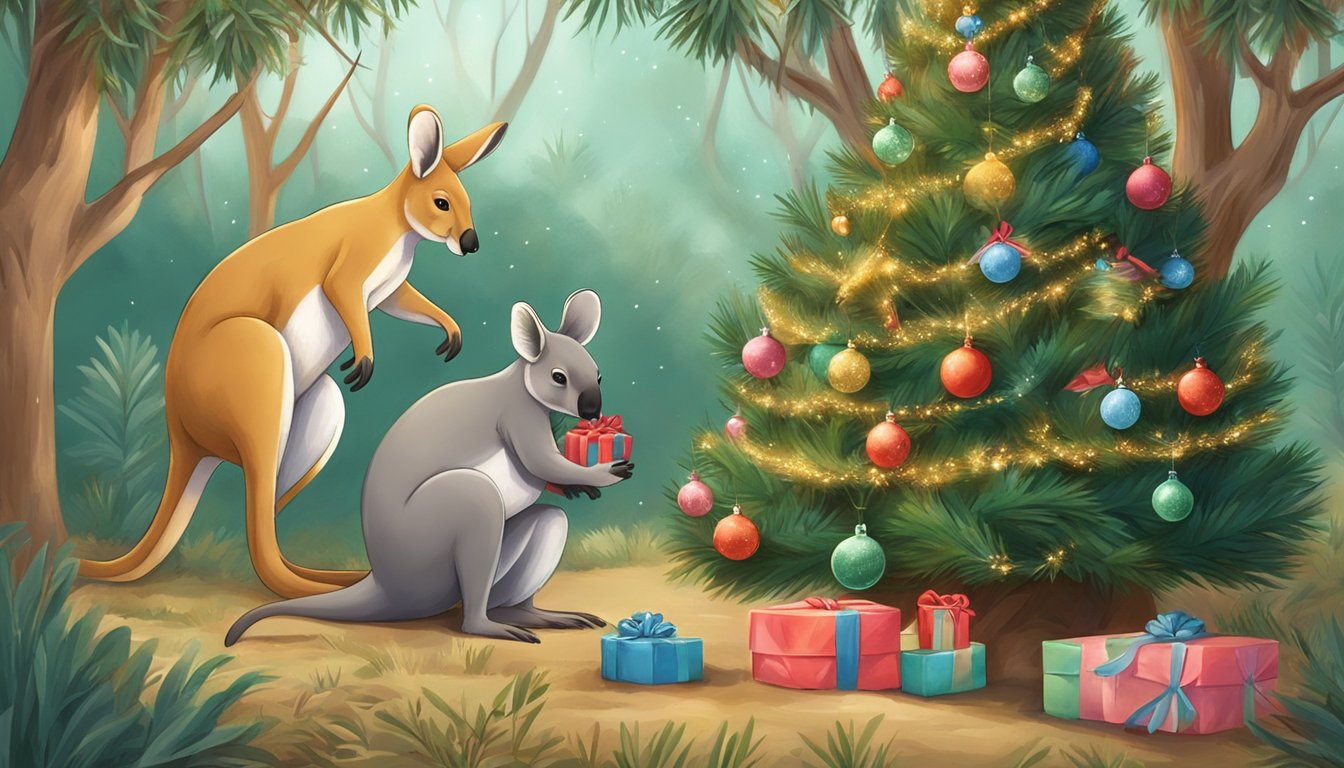
What are traditional Australian Christmas foods?
Traditional Australian Christmas foods often include seafood such as prawns and crayfish, cold meats, and salads, alongside the classic English Christmas fare like roast turkey or chicken and fruit pudding, adapted for the summer climate.
How is Christmas celebrated during the Australian summer?
Christmas in Australia is celebrated during the summer, which means many festivities occur outdoors more often than indoors.
Australians might spend the day at the beach, have barbecues, and enjoy picnics under the sun.
Can you describe some Christmas traditions unique to Australia?
The tradition of “Carols by Candlelight” is unique to Australia, where communities gather to sing Christmas songs outdoors.
Santa Claus is also given a local twist, often depicted in shorts and riding a surfboard or a “ute” pulled by kangaroos.
Why do some Australians celebrate Christmas in July?
Some Australians celebrate Christmas in July to experience the holiday in cooler weather, similar to the northern hemisphere.
This unofficial celebration is not a public holiday but provides a chance to enjoy traditional winter Christmas activities.
What popular songs embody the Christmas spirit in Australia?
Popular songs that embody Australia’s Christmas spirit include “Six White Boomers” by Rolf Harris, reflecting the Australian context with kangaroos or ‘boomers’, and the locally adapted “Jingle Bells” featuring Australian landscapes and wildlife.
How has the history of Christmas in Australia shaped current celebrations?
The history of Christmas in Australia, shaped by British colonial traditions and the country’s multicultural population, has led to a blend of practices.
Modern Australian celebrations include elements from various cultures alongside traditional British customs, tailored to fit the summer season.

